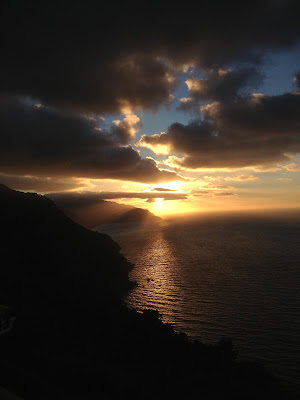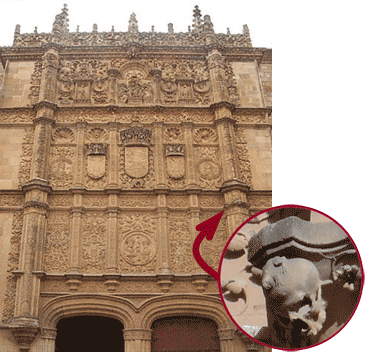It´s neat when you get to experience a place you’ve taught about in class: In one of my social sciences classes, we’ve spent weeks discussing various aspects of medieval life, from trade to professional guilds to religion. Medieval universities arose out of a desire to provide a higher level of education outside the scope of the church, and one of the most important universities established at the time was the University of Salamanca in Salamanca, Spain. Coincidentally, a few days after that lesson, a friend (Sam, whom I met studying in Costa Rica) and I headed for Salamanca.
View Larger Map
 |
| Beautiful medieval street of Old Town. |
Salamanca has an awesome history, and it’s reflected in the buildings and streets of Old Town. As an American, from a relatively young state to boot, even Boston’s 17th century roots seem ancient. So there´s something really cool about wandering through the venerable heart of a city like Salamanca, which was around before Christ.
We walked through a hulking cathedral (The “Old Cathedral”) whose construction stretched for more than a century (from the 12th to the 14th) and spanned two distinct architectural styles. We checked out the campus of the oldest and most significant university in Spain, established in the 1200s. We watched the 18th century Baroque main plaza (“Plaza Mayor”) evolve from a quiet daytime crossroads to an evening hotbed for couples, tourists and locals drinking coffee.
 |
| Plaza Mayor |
 |
| Old Cathedral |
 |
| Old Cathedral |
 |
| Old Cathedral |
 |
| View of Old Town from across the Roman bridge. |
What we didn’t do, however, was experience the city’s infamous nightlife. Being the country’s premier college town, Salamanca is synonymous with fiesta. On Saturday and Sunday, we had plans to out for a bit, at least, after taking a quick rest in the hotel after a long day of aimless wandering. Needless to say, we never made it out of our beds. Guess I’ll have to make it back to Salamanca someday. What a shame, eh?
Un saludo,
Teresa
Travel details:
How we got there: We took the Saturday morning
Alsa bus from Merida, Extremadura, to Salamanca, with a 9:50 departure and roughly 2 p.m. arrival. One-way ticket was about 19 euros. Round-trips go for about 37 euros. The Salamanca bus station is about a 15-minute walk to Old Town. Travel tip: If there’s a direct bus to your destination, but the departure time isn’t ideal, try taking an earlier bus or train closer to your destination and connect from there. The direct bus to Don Benito, Extremadura, didn’t leave until 3:30 p.m. on Monday, and I didn’t want to hang around that long, so I took the 9:50 a.m. bus to Merida and caught the 3:10 p.m. train to Don Benito. (I had to walk a mile between the Merida bus and train stations and ended up making it just in time, but in the end the stress on my heart and my body was worth getting home earlier).
Where we stayed: Our plans to
CouchSurf fell through, so we made last-minute, day-before-arrival reservations at the
Don Juan Hotel, whose name was admittedly a turn off, but we were desperate. We paid 52 euros total for two nights and two people. The place was nice, clean and quiet. If you´re looking for a party hostel or a let´s-meet-wanderers-from-all-over-the-world experience, the Don Juan is the absolute wrong place to go. But if you want something cheap, clean and well-located, it’s a great option. It’s in Old Town, about one or two minutes walking from the Plaza Mayor. The woman working (not sure if she was the owner) was great; she called the customer service line of Sam’s phone company because Sam couldn’t remember her access pin, and customer service calls in Spanish are soul-crushing.
What we did: We spent most of our time walking, which is lovely and free. We went inside the
Old Cathedral, which is free, but if you’re on a legitimate Spanish vacation, it might be worth paying a tour guide so you learn something. We paid 3.75 euros to get into the
Pontifical University building, mainly so that we could go to the top for the views. There’s a “museum” of sorts about the history of the school and a video, but both were virtually impossible to understand without spectacular Spanish. As far as we could see, there was no English. We wanted to check out the inside of the
University of Salamanca buildings, but they’re closed on Sunday afternoons (I don’t know about mornings). Keep that in mind if visiting the university is a travel priority.
 |
| Pontifical University |
 |
| Views from the top of Pontifical University |
 |
| Facade of the University of Salamanca. There's a tiny, tiny frog carved that you're supposed to find for good luck. I couldn't find it without help. |
Where we ate: The beauty of Salamanca is that it’s ripe with cheap places to eat and drink. We got good-sized coffees (good-sized for Spain, pitifully small for America) for one euro at Tutto Benne, in the Plaza Mayor next to the tourism office. They also have good, big ice cream cones – two euros for two flavors. Tons of restaurants offer menu del dia (daily lunch specials) for 10 euros or less, so if you’re on a budget, don’t pay more than that. We ate at Merlin restaurant near the university, and it was good. Nothing spectacular, but you can’t expect spectacular if you’re paying the equivalent of $13 for three courses (albeit small) and a drink in a touristy town.






























